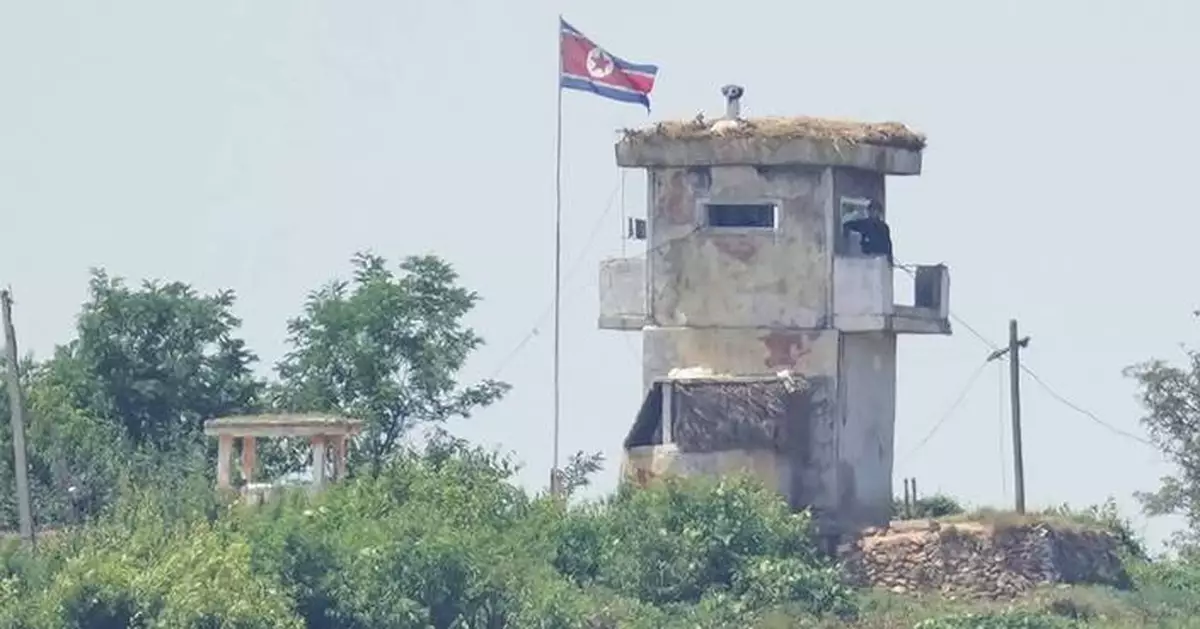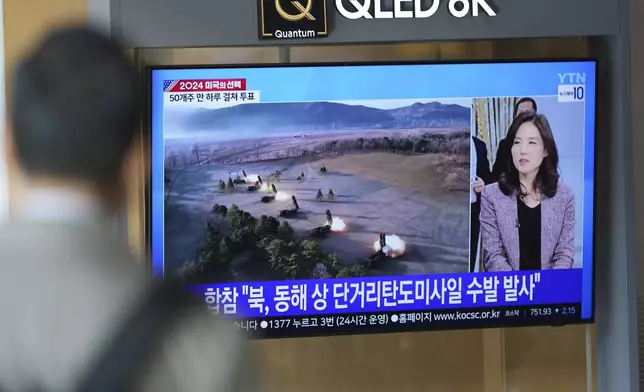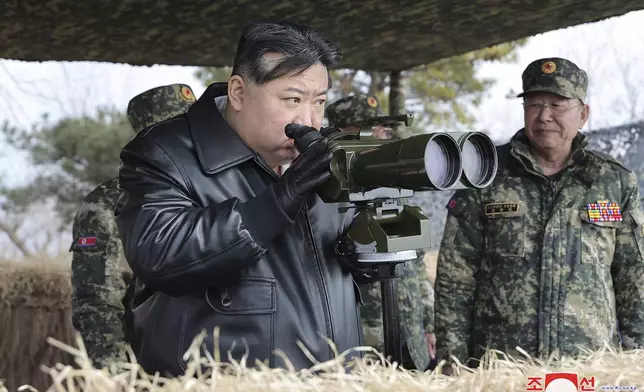SEOUL, South Korea (AP) — North Korea fired a barrage of short-range ballistic missiles into the sea on Tuesday, its neighbors said, as it continued its weapons demonstrations hours before the U.S. presidential election.
Japanese Defense Minister Gen Nakatani said at least seven North Korean missiles flew as far as 400 kilometers (250 miles) with a maximum altitude of 100 kilometers (60 miles). He said they landed in the waters between the Korean Peninsula and Japan.
Click to Gallery
A TV screen shows a report of North Korea's multiple short-range ballistic missiles with file footage during a news program at the Seoul Railway Station in Seoul, South Korea, Tuesday, Nov. 5, 2024. (AP Photo/Lee Jin-man)
A TV screen shows a report of North Korea's multiple short-range ballistic missiles with file footage during a news program at the Seoul Railway Station in Seoul, South Korea, Tuesday, Nov. 5, 2024. (AP Photo/Lee Jin-man)
A TV screen shows a report of North Korea's multiple short-range ballistic missiles with file footage during a news program at the Seoul Railway Station in Seoul, South Korea, Tuesday, Nov. 5, 2024. (AP Photo/Lee Jin-man)
Japan's Prime Minister Shigeru Ishiba speaks to journalists following North Korea's latest missile launches, at his office in Tokyo Tuesday, Nov. 5, 2024. (Kyodo News via AP)
FILE - This photo provided by the North Korean government, shows what it says a test launch of new intercontinental ballistic missile "Hwasong-19" at an undisclosed stie in North Korea Thursday, Oct. 31, 2024. Independent journalists were not given access to cover the event depicted in this image. The content of this image is as provided and cannot be independently verified. Korean language watermark on image as provided by source reads: "KCNA" which is the abbreviation for Korean Central News Agency. (Korean Central News Agency/Korea News Service via AP, File)
FILE - In this photo provided by the North Korean government, North Korean leader Kim Jong Un, left, supervises artillery firing drills in North Korea, on March 7, 2024. Independent journalists were not given access to cover the event depicted in this image. The content of this image is as provided and cannot be independently verified. Korean language watermark on image as provided by source reads: "KCNA" which is the abbreviation for Korean Central News Agency. (Korean Central News Agency/Korea News Service via AP, File)
FILE - A soldier stands at a North Korean military guard post flying a national flag, seen from Paju, South Korea, Wednesday, June 26, 2024. (AP Photo/Lee Jin-man, File)
“North Korea’s actions, including a series of repeated missile launches, threaten the peace and safety of Japan, the region and the international community,” Nakatani said.
South Korea's military also detected several missile launches by North Korea and subsequently boosted its surveillance posture. The North Korean missiles could be used to target key facilities in South Korea, including U.S. military bases there.
The launches came days after North Korean leader Kim Jong Un supervised a flight test of the country’s newest intercontinental ballistic missile d esigned to reach the U.S. mainland. In response to that launch, the United States flew a long-range B-1B bomber in a trilateral drill with South Korea and Japan on Sunday in a show of force. That drew condemnation from Kim’s powerful sister Kim Yo Jong, who on Tuesday accused North Korea’s rivals of raising tensions with “aggressive and adventuristic military threats.”
South Korean officials have said that North Korea was likely to dial up its military displays around the U.S. presidential election to command the attention of Washington. South Korea’s military intelligence agency said last week that North Korea has also likely completed preparations for its seventh nuclear test.
Outside officials and analysts say North Korea eventually hopes to use an expanded nuclear arsenal as leverage to win concessions such as sanctions relief after a new U.S. president is elected.
There are widespread views that Kim Jong Un would prefer a win by Republican candidate Donald Trump, with whom he engaged in high-stakes nuclear diplomacy in 2018-19, seeing him as a more likely counterpart to give him what he wants than Democratic candidate Kamala Harris. During campaigning, Harris said she won’t “cozy up to tyrants and dictators like Kim Jong Un who are rooting for Trump.”
North Korea claimed that the Hwasong-19 it tested on Oct. 31 was “the world’s strongest” ICBM, but experts say the solid-fuel missile is too big to be useful in war. Experts say North Korea has yet to acquire some critical technologies to build a functioning ICBM, such as ensuring that the warhead survives the harsh conditions of atmospheric re-entry.
Tensions between the Koreas are at their highest point in years as Kim has repeatedly flaunted his expanding nuclear weapon and missile programs, while reportedly providing Russia with munitions and troops to support President Vladimir Putin’s war in Ukraine.
On Monday, U.S. State Department spokesperson Matthew Miller told reporters that as many as 10,000 North Korean soldiers were in Russia’s Kursk region near Ukraine’s border and were preparing to join Moscow’s fight against Ukraine in the coming days. If they engage in combat, it would be North Korea’s first participation in a large-scale conflict since the end of the 1950-53 Korean War.
After a meeting in Seoul on Monday, senior South Korean and European Union officials expressed concerns about Russia’s possible transfer of technology to North Korea to enhance its nuclear program in exchange for its troops. Such transfers would “jeopardize the international non-proliferation efforts and threaten peace and stability on the Korean Peninsula and across the globe,” they said.
In response to North Korea’s growing nuclear threat, South Korea, the United States and Japan have been expanding their combined military exercises. North Korea has portrayed such U.S.-led military drills as rehearsals for an invasion and used them to justify its relentless pursuit of nuclear weapons and missiles.
At a U.N. Security Council meeting Monday, North Korea’s ambassador, Kim Song, defended the North's nuclear and ICBM programs as a necessary response to what it perceives as nuclear threats from the United States. U.S. Deputy Ambassador Robert Wood warned that the U.S. cannot stand back from North Korea’s expanding nuclear program and the growing threat to U.S. security “without a response.”
Wood also repeated last week’s call for Russia to say whether there are North Korean troops on the ground in Russia. “We’re not in a court here,” Russian Deputy Ambassador Anna Evstigneeva replied, “and the questions of the United States, in the spirit of an interrogation, is not something I intend to answer.”
Yamaguchi reported from Tokyo. Associated Press writer Edith M. Lederer at the United Nations contributed to this report.

A TV screen shows a report of North Korea's multiple short-range ballistic missiles with file footage during a news program at the Seoul Railway Station in Seoul, South Korea, Tuesday, Nov. 5, 2024. (AP Photo/Lee Jin-man)

A TV screen shows a report of North Korea's multiple short-range ballistic missiles with file footage during a news program at the Seoul Railway Station in Seoul, South Korea, Tuesday, Nov. 5, 2024. (AP Photo/Lee Jin-man)
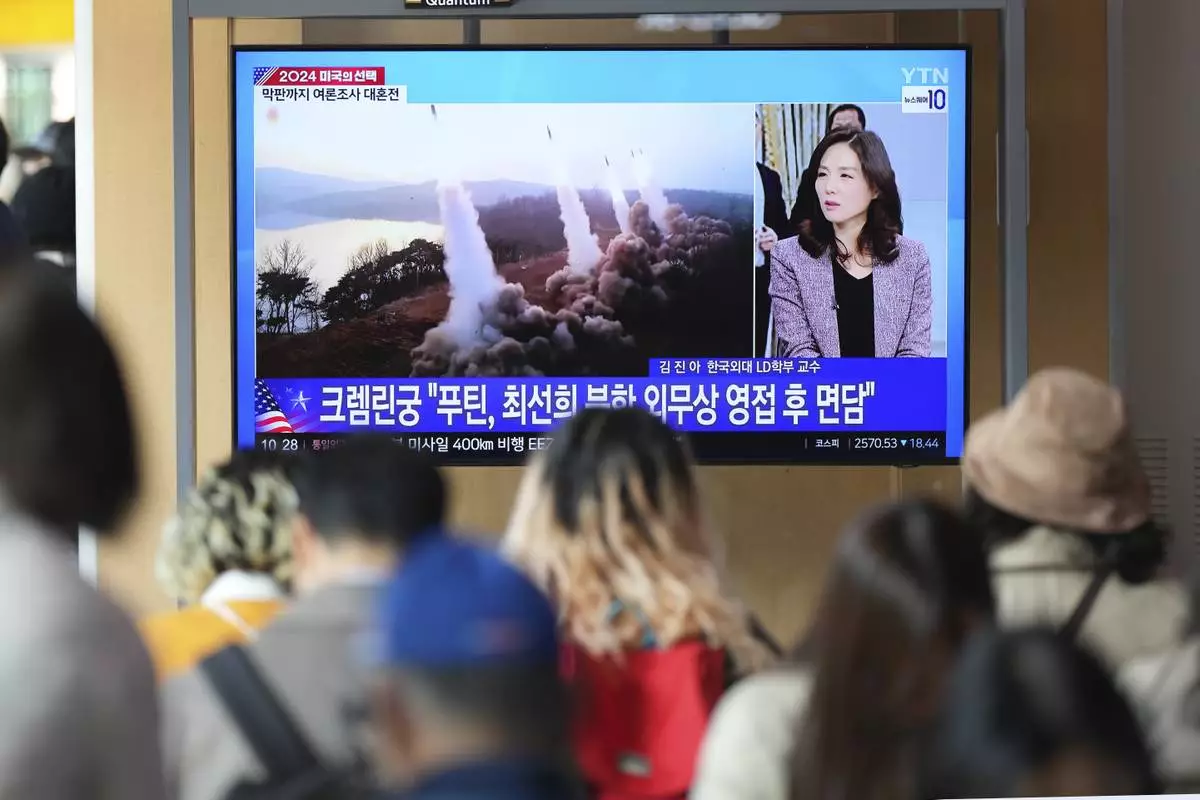
A TV screen shows a report of North Korea's multiple short-range ballistic missiles with file footage during a news program at the Seoul Railway Station in Seoul, South Korea, Tuesday, Nov. 5, 2024. (AP Photo/Lee Jin-man)

Japan's Prime Minister Shigeru Ishiba speaks to journalists following North Korea's latest missile launches, at his office in Tokyo Tuesday, Nov. 5, 2024. (Kyodo News via AP)
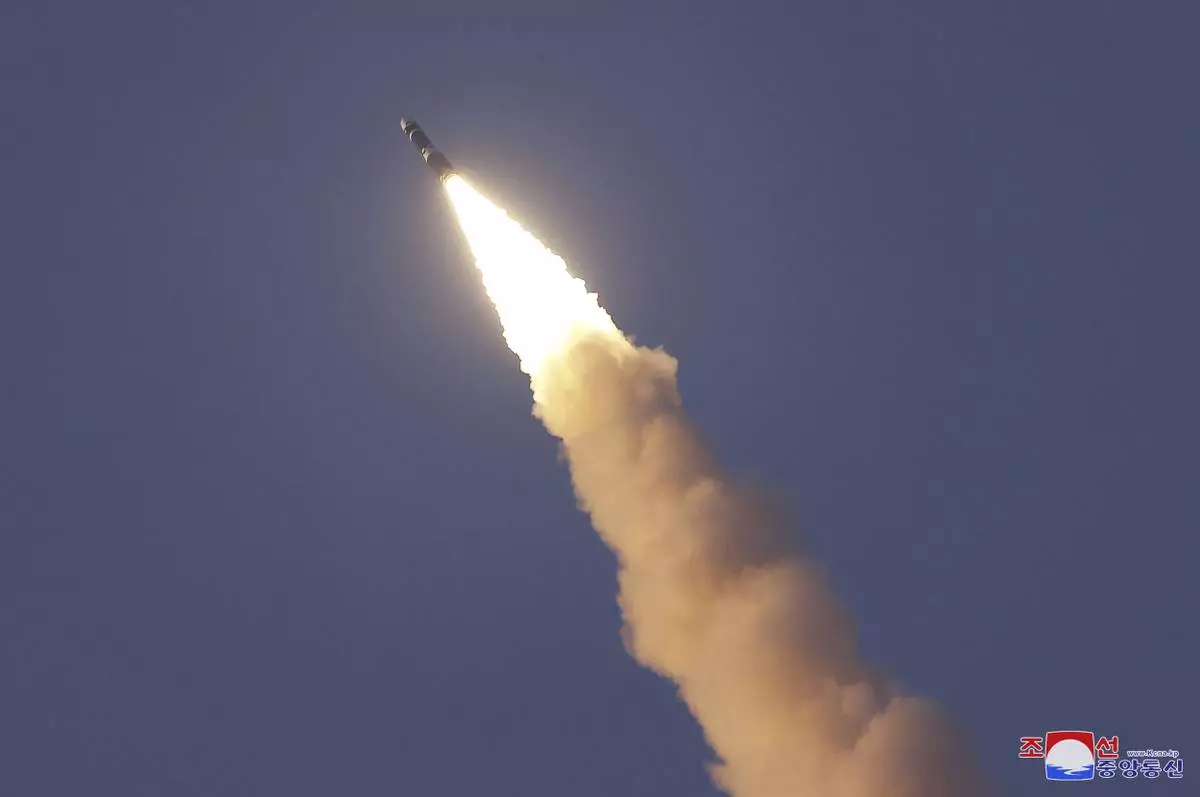
FILE - This photo provided by the North Korean government, shows what it says a test launch of new intercontinental ballistic missile "Hwasong-19" at an undisclosed stie in North Korea Thursday, Oct. 31, 2024. Independent journalists were not given access to cover the event depicted in this image. The content of this image is as provided and cannot be independently verified. Korean language watermark on image as provided by source reads: "KCNA" which is the abbreviation for Korean Central News Agency. (Korean Central News Agency/Korea News Service via AP, File)

FILE - In this photo provided by the North Korean government, North Korean leader Kim Jong Un, left, supervises artillery firing drills in North Korea, on March 7, 2024. Independent journalists were not given access to cover the event depicted in this image. The content of this image is as provided and cannot be independently verified. Korean language watermark on image as provided by source reads: "KCNA" which is the abbreviation for Korean Central News Agency. (Korean Central News Agency/Korea News Service via AP, File)
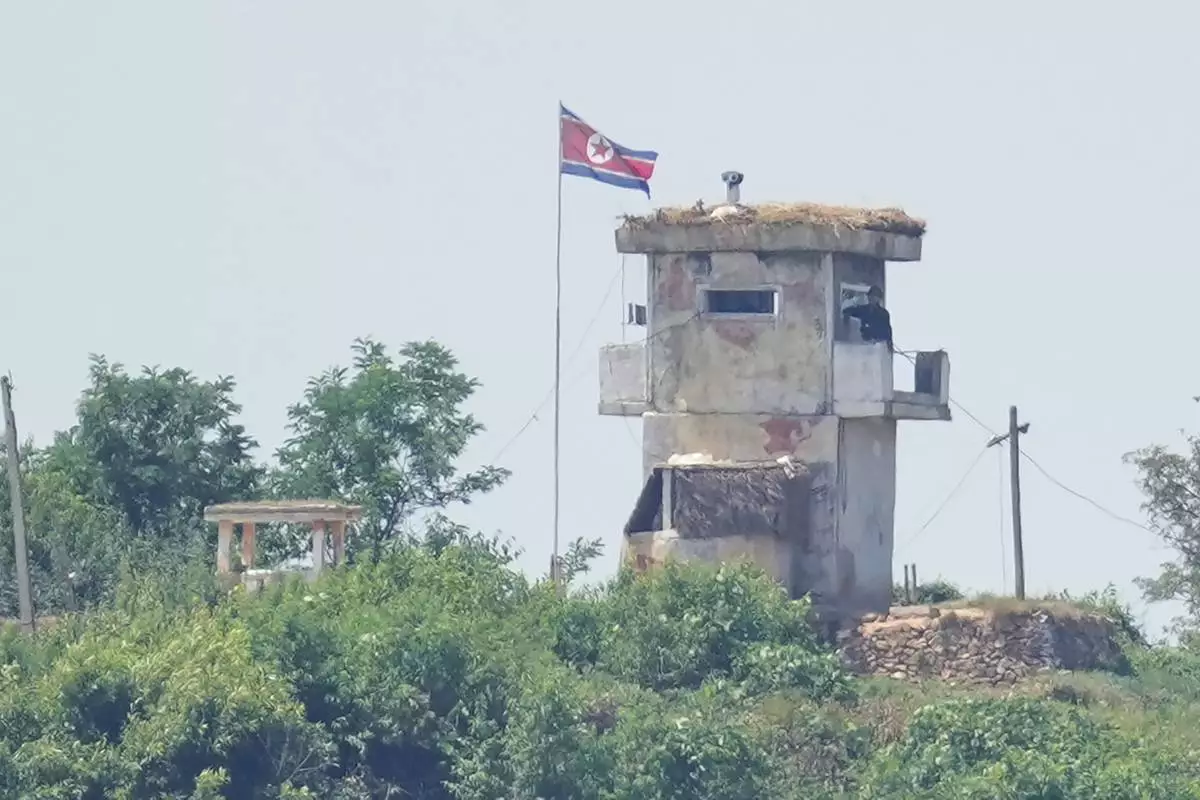
FILE - A soldier stands at a North Korean military guard post flying a national flag, seen from Paju, South Korea, Wednesday, June 26, 2024. (AP Photo/Lee Jin-man, File)
Israeli airstrikes killed at least 40 people on Thursday across central and southern Gaza, including an attack on a sprawling tent camp that Israel has repeatedly bombed despite designating it a humanitarian safe zone. Israel said the strike targeted a righ-ranking police officer, and blames Hamas for civilian deaths.
Israeli Prime Minister Benjamin Netanyahu’s office said Thursday he authorized a delegation from the country's intelligence services and military to continue negotiations in Qatar toward a ceasefire deal in Gaza. There was no immediate comment from Hamas.
American, Qatari and Egyptian mediators have spent nearly a year trying to broker a ceasefire and hostage release, but their efforts have repeatedly stalled.
The Israeli military also claimed responsibility Thursday for a commando raid in western Syria last September that destroyed what it said was an Iranian-led missile factory.
Israel’s war in Gaza has killed over 45,500 Palestinians, according to local health officials, who say women and children make up more than half the fatalities. The officials do not distinguish between civilians and combatants in their tally.
The war was sparked by Hamas-led militants' Oct. 7, 2023 attack into Israel. They killed some 1,200 people, mostly civilians, and abducted around 250 that day. Around 100 hostages are still inside Gaza, at least a third of whom are believed to be dead.
Here's the latest:
JERUSALEM — The Israeli military says a missile fired from Yemen has set off air raid sirens in Jerusalem and central Israel.
The attack, at 4:30 a.m. Friday, woke millions of people and sent people scrambling to air raid shelters.
There were no immediate reports of injuries or damage, though a faint explosion, likely either from the missile or from interceptors, could be heard in Jerusalem.
The military said interceptors were launched toward the target and the results are under review.
Yemen’s Houthi rebels have been launching missiles and drones at Israel nearly every day in recent weeks.
Israel has carried out a number of long-range airstrikes in Yemen, some 2,000 kilometers (1,200 miles) away. But the strikes have failed to stop the attacks.
The Houthis have pledged to continue striking Israel until the war in Gaza ends.
DEIR AL-BALAH, Gaza Strip — Israeli strikes in the Maghazi and Nuseirat refugee camps in central Gaza killed at least 14 people late Thursday, including four women and five children.
They were taken to Al-Aqsa Martyrs Hospital, where an Associated Press journalist counted the bodies, bringing the death toll on Thursday to at least 40 people.
The Israeli army did not immediately comment on the strikes, but says it only targets militants and blames Hamas for civilian deaths.
Earlier Israeli strikes killed dozens more people throughout central and southern Gaza, including inside a sprawling tent camp that Israel designated a humanitarian safe zone but has repeatedly targeted. Israel's military said that strike killed a high-ranking police officer who was involved in gathering intelligence used by Hamas’ armed wing in attacks on Israeli forces.
GENEVA — The head of the U.N. World Health Organization says Israel is still allowing only a trickle of sick and wounded people in the Gaza Strip to travel abroad for life-saving medical treatment.
At least 5,383 patients have been evacuated with the WHO's help since the war broke out in October 2023, leaving more than 12,000 Palestinians still waiting to leave Gaza, said WHO director Tedros Adhanom Ghebreyesus in a statement Thursday.
The rate of evacuations plunged when the Rafah border crossing shut down in May after Israeli troops took it over — since then, only 436 patients have left Gaza, Tedros said.
“At this rate, it would take 5-10 years to evacuate all these critically ill patients, including thousands of children,” Tedros said. “In the meantime, their conditions get worse and some die.”
He urged Israel to increase the approval rate for medical evacuations, including no denials of child patients, and to allow all possible corridors and border crossings to be used. Israel controls all the entry and exit points for Gaza.
COGAT, the Israeli military agency in charge of humanitarian affairs for Palestinians, has said it does everything it can to approve medical evacuations, which are contingent upon a security check. It did not respond when asked for comment on the latest WHO figures.
BEIRUT — Israel's military said Thursday it struck rocket launchers used by Hezbollah militants in southern Lebanon, a rare attack outside the border areas where Israeli forces conduct near-daily operations since a ceasefire went into effect last November, according to Lebanese state media.
Under the ceasefire agreement, Israel has until Jan. 25 to withdraw its forces from Lebanon, while Hezbollah militants must relocate north of the Litani River.
Israel says it has the right to attack Hezbollah anywhere for alleged ceasefire violations, and that Thursday's strikes were in Nabatiyeh province, which straddles both sides of the Litani.
Video circulated on social media of a strike in Jbaa, in the Iqlim al-Tuffah region, showing large flames and secondary explosions.
No casualties were reported by Lebanon’s National News Agency. Hezbollah did not immediately comment on the attack.
Israeli operations in Lebanon since the ceasefire have included gunfire, house demolitions, excavations, tank shelling and airstrikes. These actions have killed at least 27 people, wounded more than 30 and destroyed residential buildings.
JERUSALEM — Israeli Prime Minister Benjamin Netanyahu’s office says he has authorized a delegation from the Mossad intelligence agency, the Shin Bet internal security agency and the military to continue negotiations in Qatar toward a ceasefire deal in Gaza.
The statement had no further details, but Israeli media said the delegation would depart Friday.
There was no immediate comment from the Hamas militant group.
The U.S.-led talks have repeatedly stalled, and at one point last year Qatar suspended its mediation efforts, expressing frustration. Egypt also is a mediator.
DEIR AL-BALAH, Gaza Strip — Israeli airstrikes killed at least 26 Palestinians across the Gaza Strip on Thursday as the 15-month war with Hamas dragged on.
A strike killed five policemen in the southern city of Khan Younis and their bodies were taken to Nasser Hospital, medical officials there said.
Three Palestinians were killed in a separate Israeli strike in central Gaza that hit a group of people walking in the street in the built-up Maghazi refugee camp, according to Al-Aqsa Martyrs Hospital.
An earlier strike in nearby Deir al-Balah killed eight people who were helping secure humanitarian aid convoys, the hospital said.
At least 10 people were also killed Thursday morning by an airstrike in southern Gaza's Muwasi area, inside an Israeli-declared humanitarian zone. The dead included three children and two senior police officers. Israel said that strike targeted a senior member of Hamas’ internal security apparatus.
Israel has repeatedly targeted Gaza's police force, which was part of the Hamas-run government, contributing to a breakdown of law and order that has made it difficult for humanitarian groups to deliver aid. Israel accuses Hamas of hijacking aid for its own purposes.
JERUSALEM -- The Israeli military has claimed responsibility for a nighttime raid in Syria last September in which it says dozens of commandos destroyed a top-secret Iranian-led missile factory.
Israeli military spokesman Lt. Col. Nadav Shoshani said Thursday that Iran, working with its Syrian and the Hezbollah allies, planned to build hundreds of precision guided missiles per year at the factory that could be transferred to Lebanon. He said the facility was located in western Syria around the town of Masyaf near the Lebanese border.
He said Israel had been monitoring the underground facility for several years, but decided to strike at a time when Israel was at war with Hezbollah and the factory was becoming operational.
“This facility posed a clear threat to the state of Israel and this is why we had to take action,” he said.
Shoshani said over 100 special force soldiers took part in the Sept. 8 raid, backed by dozens of aircraft. Calling it one of Israel’s most complex operations in years, he said soldiers arrived by helicopter and entered the facility, which he said was dug deep into the side of a mountain.
In bodycam footage released by the Israeli military, special forces are seen moving through wide underground hallways and seizing documents, before a large explosion destroys the site. The video, which could not be independently verified, also showed images of what the army said was missile-manufacturing equipment.
At the time, Syrian state media reported 18 deaths from a series of Israeli airstrikes in the area. Shoshani said there were no Israeli casualties, and that Israel also damaged another missile-production facility in Lebanon during the war.
Israel and Hezbollah reached a cease-fire in late November, halting nearly 14 months of fighting.
JERUSALEM — Israeli Prime Minister Benjamin Netanyahu was released from the hospital Thursday after recovering from prostate surgery Sunday.
Doctors at Hadassah Ein Kerem Hospital said Netanyahu was recuperating satisfactorily, although he still has a period of recovery ahead. Medical follow-ups will continue as usual, according to a hospital statement.
Despite doctor’s orders to remain hospitalized, the 75-year-old leader had briefly left the facility to participate in a vote in Israel’s parliament on Tuesday.
KYIV, Ukraine – Ukraine’s president says his country is poised to reestablish diplomatic ties with Syria after the fall of President Bashar Assad and sharply increase agricultural exports to Lebanon despite being engaged in an almost three-year war with Russia.
The developments came after a recent visit to those countries by Ukraine’s top diplomat and its government minister for farming, according to a statement from Ukrainian President Volodymyr Zelenskyy on Thursday. Ukraine is aiming to build up its security and trade relations in the Middle East, he said.
Ukraine and Syria are assessing cooperation within international organizations, and Syria could this year become a “reliable partner” for Ukraine, Zelenskyy said.
The Ukrainian officials met with Syria’s new de facto authorities led by the Islamist group Hayat Tahrir al-Sham. The insurgents had ousted Assad, a longtime ally of Russian President Vladimir Putin, in early December.
Ukrainian agricultural exports to Lebanon are around $400 million a year but Zelenskyy said he hopes to at least double that.
Ukraine is a leading world producer of wheat, corn, barley, sunflower oil and other food products.
JERUSALEM — The Israeli military says it targeted a senior member of Hamas’ internal security apparatus in a strike in the Gaza Strip that Palestinian officials say killed nine other people, including three children.
The strike early Thursday hit a tent in an Israeli-declared humanitarian zone known as Muwasi, where hundreds of thousands of displaced people are sheltering in tents during the cold and rainy winter.
The military said Hossam Shahwan, a senior officer in the Hamas-run police force in Gaza, was involved in gathering intelligence used by Hamas’ armed wing in attacks on Israeli forces.
Maj. Gen. Mahmoud Salah, another senior police official, was also killed in the strike.
The military says Hamas militants hide among civilians and blames the group for their deaths in the nearly 15-month war, which was ignited by Hamas’ Oct. 7, 2023 attack into Israel.
The Hamas-run government had a police force numbering in the tens of thousands that maintained a high degree of public security before the war while also violently suppressing dissent.
The police have largely vanished from the streets in many areas after being targeted by Israel, contributing to the breakdown of law and order that has hindered the delivery of desperately needed humanitarian aid.
DAMASCUS, Syria — The forces together with armed vehicles were deployed in the city of Homs Thursday to look for the militants affiliated with ousted President Bashar Assad, state media reported.
SANA, citing a military official, said that the new de facto authorities led by the Islamist group Hayat Tahrir al-Sham had set up centers in Syria’s third-largest city for former soldiers and militants to hand over their weapons, similar to other parts of Syria.
In early December, a lightning insurgency took out the decades-long rule of Assad in less than two weeks. HTS has since run much of war-torn Syria under the authority of its leader Ahmad al-Sharaa.
Officials who were part of Assad's notorious web of intelligence and security apparatus have been arrested over the past few weeks.
DEIR AL-BALAH, Gaza Strip — An Israeli strike has killed at least eight Palestinian men in the central Gaza Strip.
The dead were members of local committees that help secure aid convoys, according to Al-Aqsa Martyrs Hospital, which received the bodies. An Associated Press reporter at the hospital confirmed the toll.
Earlier on Thursday, an Israeli airstrike in southern Gaza killed at least 10 people, including three children and two senior officers in the Hamas-run police.
There was no immediate comment from the Israeli military on the strikes.
Israel has repeatedly targeted the police, contributing to a breakdown of law and order in the territory that has made it difficult for humanitarian groups to deliver aid. Israel accuses Hamas of hijacking aid for its own purposes.
DUBAI, United Arab Emirates — Al Jazeera has condemned the Palestinian Authority’s decision to bar it from operating in the occupied West Bank, saying the decision was “in line” with similar actions taken by Israel.
In a statement Thursday, the Qatar-based broadcaster accused the Western-backed authority of seeking to “hide the truth about events in the occupied territories, especially what is happening in Jenin and its camps.”
The Palestinian Authority, which cooperates with Israel on security matters, launched a rare crackdown on anti-Israel militants in the urban Jenin refugee camp last month. The authority has international support but is unpopular among many Palestinians, with critics portraying it as a subcontractor of the Israeli occupation.
The Palestinian Authority announced the suspension of Al Jazeera’s activities on Wednesday, accusing it of incitement and interfering in Palestinian internal affairs. The Palestinian Authority exercises limited autonomy in parts of the Israeli-occupied West Bank.
Israel banned Al Jazeera last year, accusing it of being a mouthpiece of Hamas. Israeli strikes have killed or wounded several Al Jazeera reporters in Gaza, and Israel has accused some of them of being militants. Israeli forces raided Al Jazeera’s West Bank headquarters last year, but the broadcaster has continued to operate in the territory.
Al Jazeera denies the allegations and accuses Israel of trying to silence its coverage. Its 24-hour reporting from Gaza has focused on the deaths of Palestinian civilians. It has also broadcast Hamas and other militant videos in their entirety, showing attacks on Israeli forces and hostages speaking under duress.
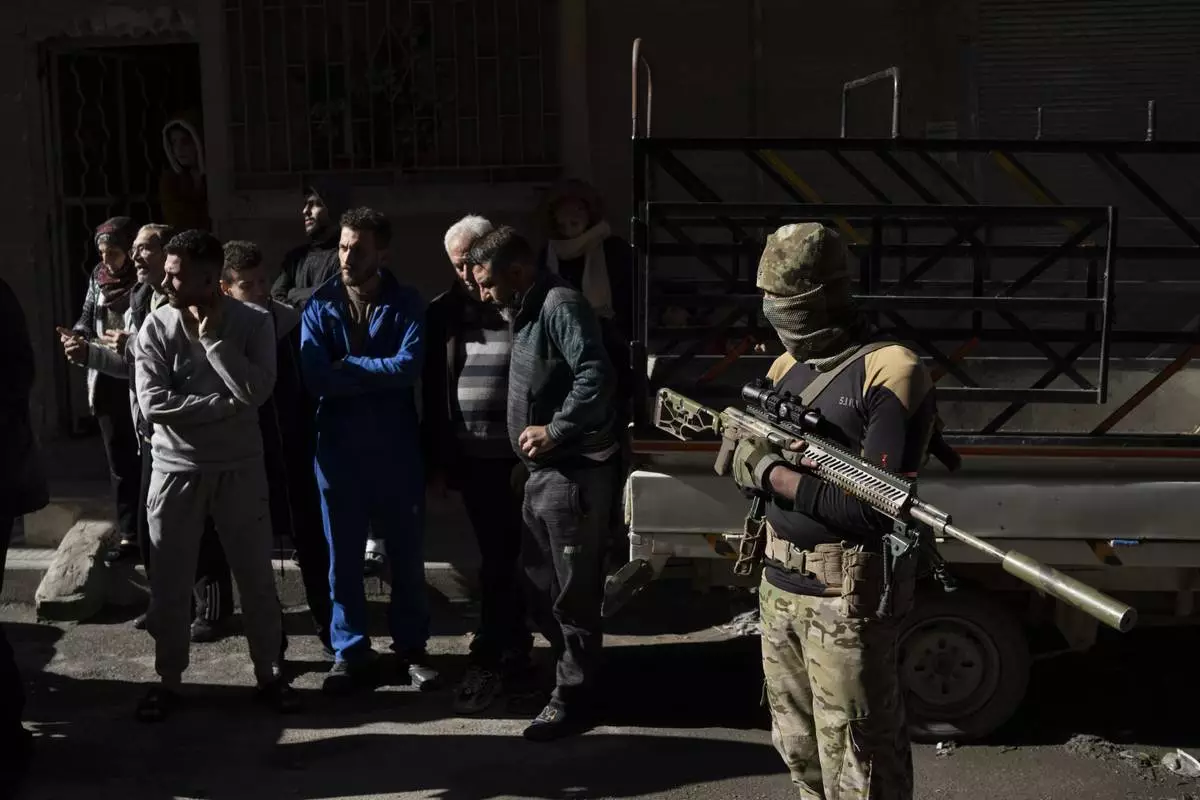
People stand outside their homes at a residential area as members of the new security forces take part in an operation to detain, according to the state media, militiamen affiliated with ousted president Bashar Assad in Homs, Syria, Thursday, Jan. 2, 2025. (AP Photo/Leo Correa)

People stand outside their homes at a residential area as members of the new security forces take part in an operation to detain, according to the state media, militiamen affiliated with ousted president Bashar Assad in Homs, Syria, Thursday, Jan. 2, 2025. (AP Photo/Leo Correa)
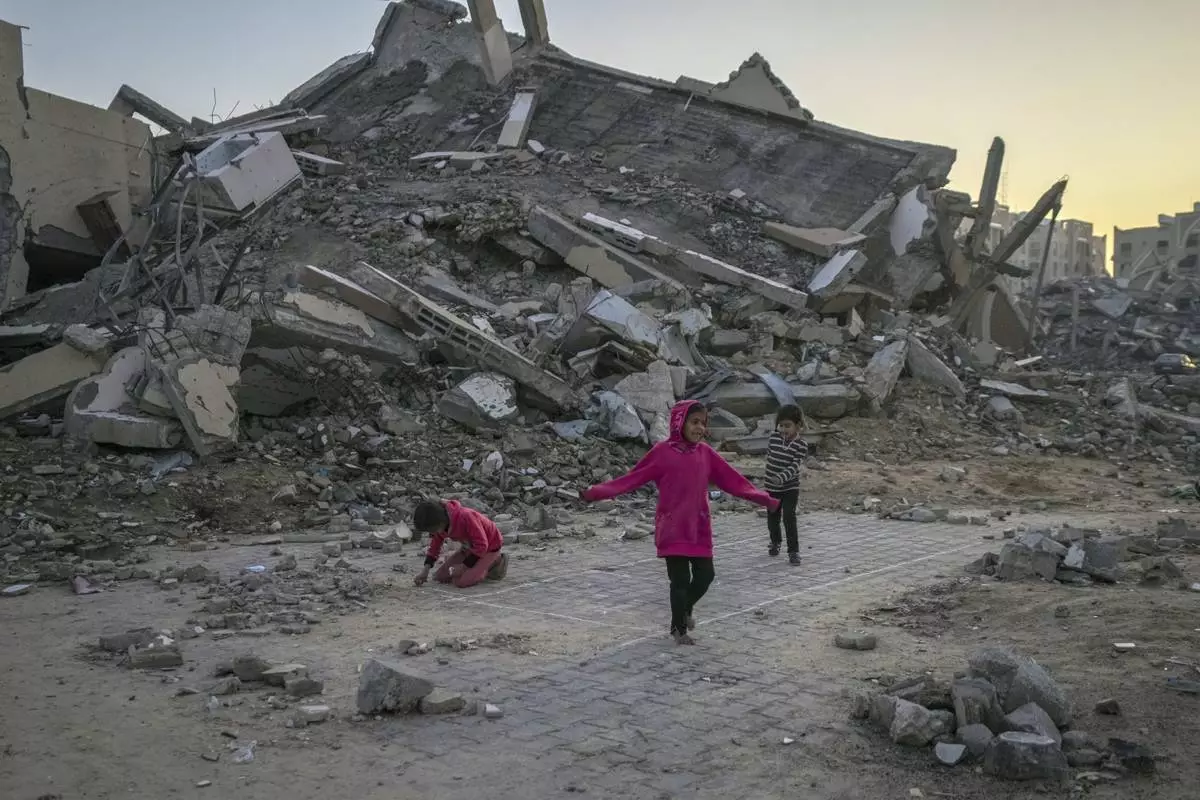
Palestinian children play next to a building destroyed by Israeli army strikes in the central Gaza Strip town of Khan Younis, Wednesday, Jan. 1, 2025. (AP Photo/Abdel Kareem Hana)
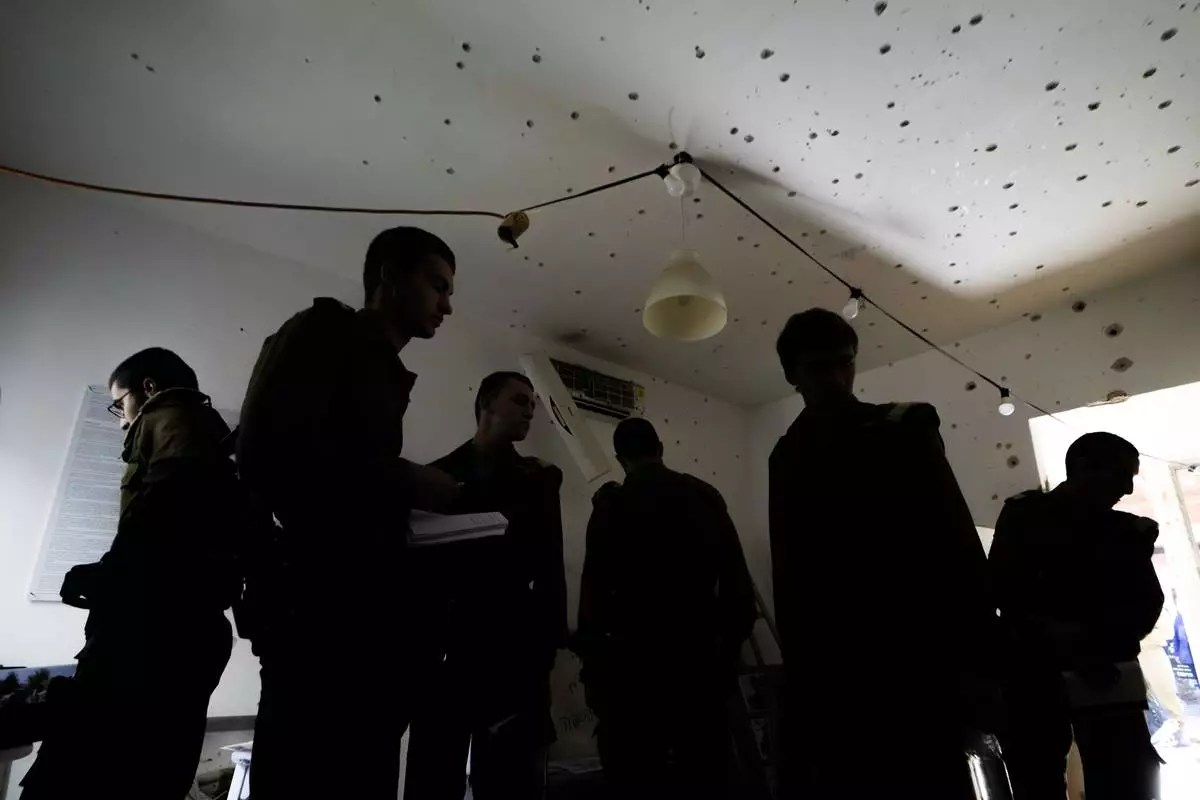
Israeli soldiers stand in a bullet-ridden house during a tour for army personnel to observe the damage caused by the Oct. 7 Hamas onslaught at Kibbutz Kfar Aza, near the Israeli-Gaza border, in Israel, Thursday, Jan. 2, 2025. (AP Photo/Matias Delacroix)

An Israeli soldier jumps off an armoured vehicle at a staging area near the Gaza border in southern Israel, Thursday Jan. 2, 2025. (AP Photo/Tsafrir Abayov))

Palestinians prepare the body for the funeral of a man killed during an Israeli army strike in Deir al-Balah in the central Gaza Strip, Thursday Jan. 2, 2025. The strike killed at least eight men members of local committees that help secure aid convoys, according to the Al-Aqsa Martyrs Hospital, which received the bodies.(AP Photo/Abdel Kareem Hana)
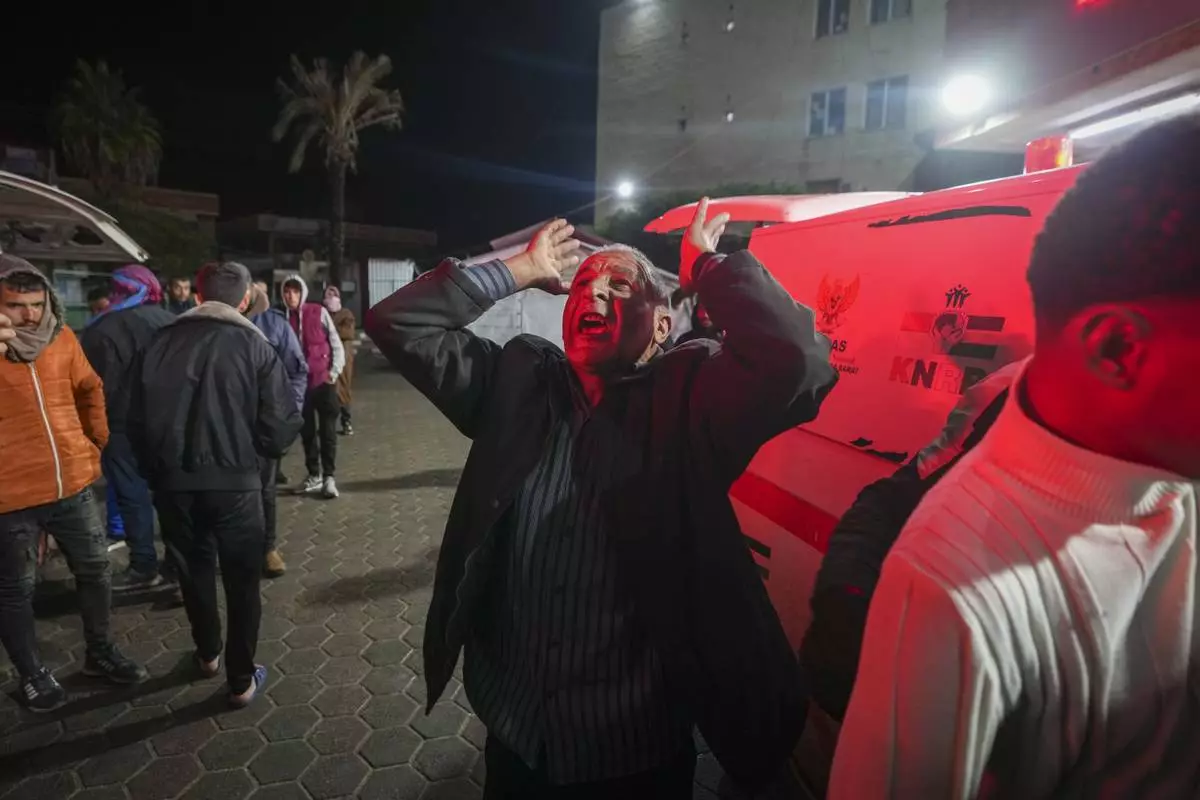
A man reacts in grief as the body of 8-year-old Adam Farajallah is brought to Al-Aqsa Martyrs Hospital following an airstrike on a house in the Bureij refugee camp, in the central Gaza Strip town of Deir al-Balah Wednesday, Jan. 1, 2025. (AP Photo/Abdel Kareem Hana)
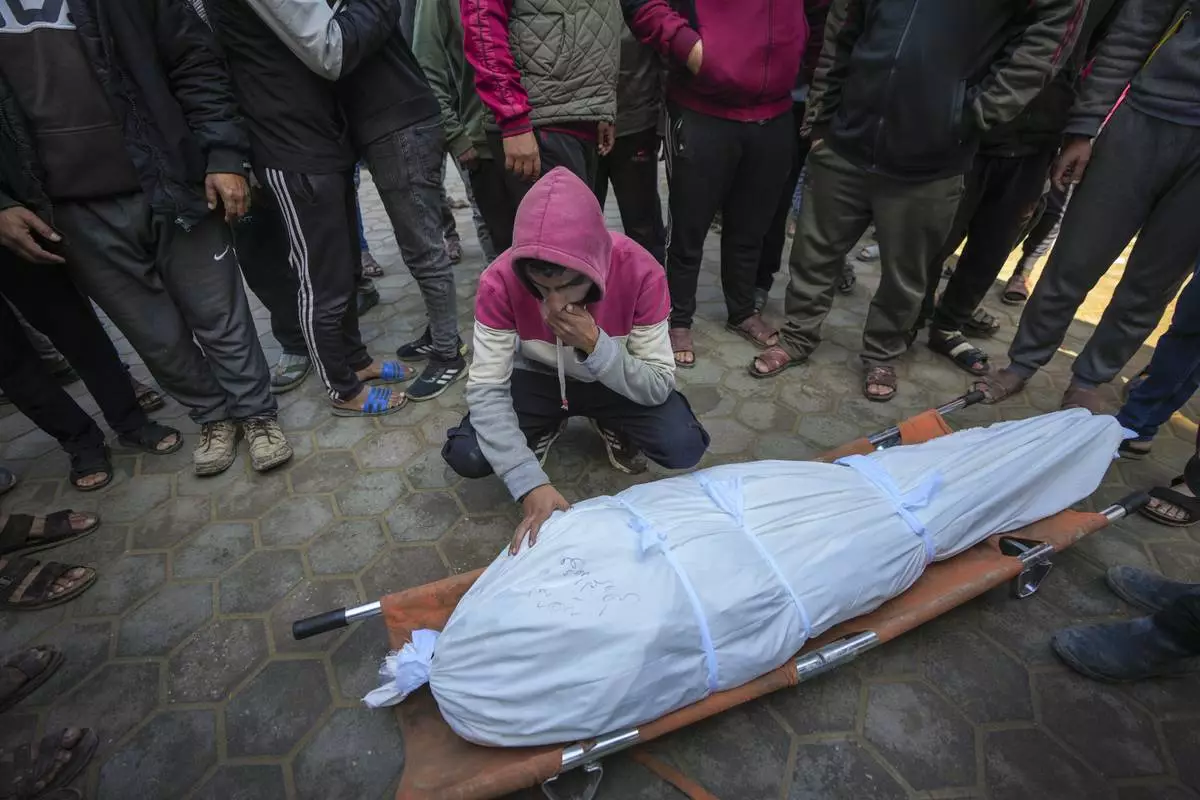
A man mourns over the body of a Palestinian man killed during an Israeli army strike in Deir al-Balah in the central Gaza Strip, Thursday Jan. 2, 2025. The strike killed at least eight men members of local committees that help secure aid convoys, according to the Al-Aqsa Martyrs Hospital, which received the bodies.(AP Photo/Abdel Kareem Hana)
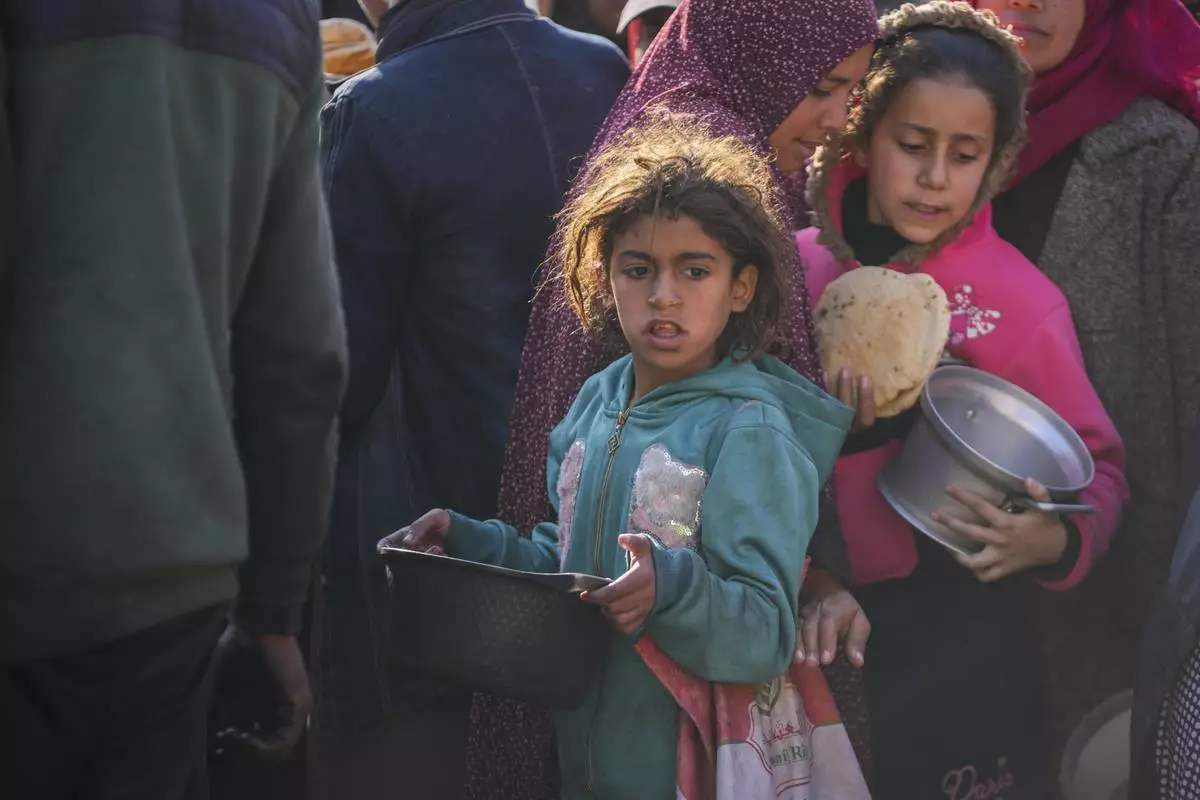
Palestinian girls collect donated food at a food distribution center in Deir al-Balah, central Gaza Strip, Thursday Jan. 2, 2025. (AP Photo/Abdel Kareem Hana)

An Israeli soldier covers his ears as an artillery gunner fires into the Gaza Strip from a position in southern Israel, Thursday, Jan. 2, 2025.(AP Photo/Matias Delacroix)
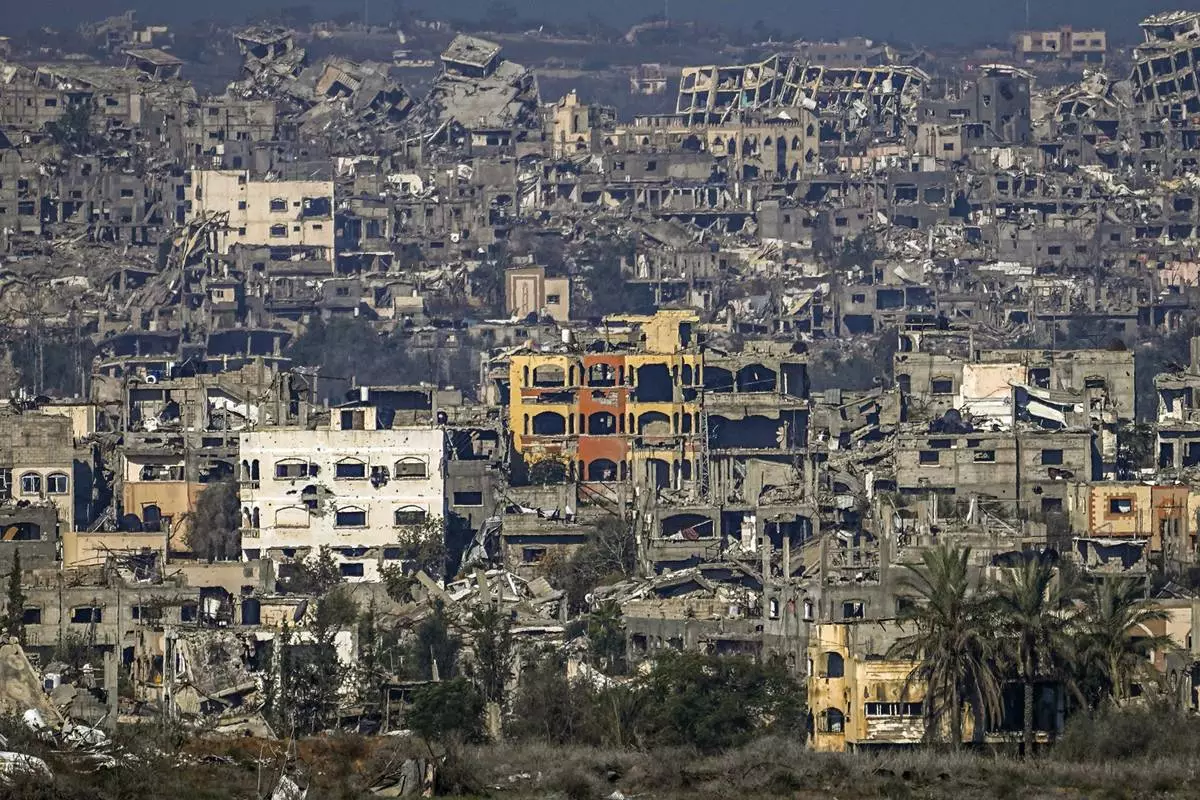
A destroyed part of Gaza City as seen from southern Israel, Thursday Jan. 2, 2025. (AP Photo/Tsafrir Abayov))

Palestinians inspect the site of an earlier Israeli army strike in the Muwasi area, in Khan Younis, central Gaza Strip, Thursday Jan. 2, 2025. According to Palestinian medical officials, the airstrike killed at least 10 people, including three children and two senior police officers, in an Israeli-designated humanitarian zone in the Gaza Strip. (AP Photo/Abdel Kareem Hana)









